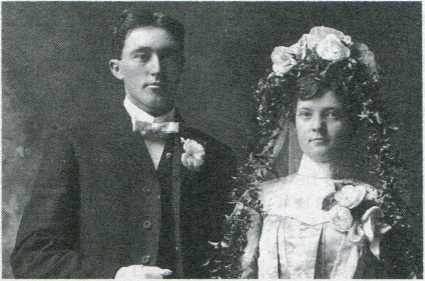haymow above. There was a hole in the floor of the haymow the size of a hay bale through which each bale was thrown. The trick was to get the bale to go down the hole without going down with it. One time Sue’s sister, Nancy, did not get it quite right and both she and the bale went down the hole. In the summer when the cows were put out in the pasture, it was the girls’ job to get the cows for milking. Invariably the cows seemed to be at the far end of the pasture.
The pigs were fed corn. This was simply a matter of shoveling some corn out of the corn crib on to the feed floor. The chickens were fed ground corn and commercial chicken feed. In addition to feeding the chickens, the eggs had to be gathered, cleaned and packed in cardboard cases. Some hens were reluctant to give up their eggs and would peck the back of your hand as you reached under them to get the eggs. The girls sometimes complained about having to help in the barn. Their father’s reply always was, “That is where the new dresses come from!" In the spring and summer Sue and her sisters would help drag the fields after the crops were planted and help load and unload hay bales during haying season.
Sue and her sisters were all members of the Pleasant Livewires 4-H Club. In addition to sewing, cooking and home furnishing projects, they always kept a record book of the family garden - when it was planted, when they began harvesting vegetables and how many quarts were canned or frozen. Sue was in 4-H for 7 years. During that time she exhibited a number of things and gave several demonstrations at the Winneshiek Co. Fair. A demonstration on "How to Make Pineapple Cheesecake" by Sue and Dianne Bigler won a purple ribbon at the local fair. Sue and Dianne then gave their demonstration at the National Dairy Cattle Congress in Waterloo, IA.
While Sue was growing up, the Jacobsens were members of the Canoe Ridge Lutheran Church where she was baptized, confirmed, attended Sunday School and Luther League and later helped teach summer Bible School.
Sue first attended Pleasant No. 6 (known as the Daubney School) and Pleasant No. 5 where she graduated from the 8th grade. Both of these were one-room schools. She entered Decorah High School graduating in 1963.
Sue then attended and graduated from the University of Northern Iowa in Cedar Falls, IA. She majored in Biology and was inducted into the national biology society, Beta Beta Beta. While in college, one of her most memorable experiences was the time she spent in Mississippi during the summer of 1964. This was known as “Freedom Summer.” A number of northern college students went to Mississippi to help with the voter registration drive or simply to show their support for the civil rights movement. They were met with suspicion and anger by the white Mississippians. In some cases they encountered violence and in the case of 3 young men, death.
Sue remained in the Waterloo/Cedar Falls area until the spring of 1977 when she returned to Decorah. Since Jun 1978 Sue has been employed at the Aase Haugen Home in Decorah where she is presently Director of Social Services. Sue has had a number of interests and hobbies over the years, including fishing, ceramics, handiwork and refinishing furniture. She has now abandoned these and devotes her free time to the Decorah Genealogy Association.
Jarland, Lewis and Lisa (Grindeland)
(Sylvia Akre)

Lewis and Lisa (Grindeland) Jarland
Lewis John Jarland (b. 16 Dec 1879 in Highland Twp.) was the son of Tosten Jarland who was born in Bergen, Norway and Oline Langland Jarland (b. 1 Jan 1842 in Highlandville IA.) Tosten had emigrated to America in 1857. This Jarland family included 12 children, six of whom died at a young age due to a siege of typhoid fever.
Lewis learned the carpenter’s trade as did his brother Henry. They were known as the Jarland Bros. Co. They built several homes in Spring Grove, MN, and in Highland Twp., including the Akre home in Highlandville where Lewis’s daughter Sylvia resided for 23 years. The Big Canoe Church was another building the Jarland Brothers helped to build.
On 1 Oct 1903 Lewis married Lisa Karine Grindeland, the daughter of David Enevold Grindeland and Maret Knoff. Lisa had 2 brothers, Albert M. and Herbert Grindeland.
In 1911 they migrated to northwestern ND with their 4 sons—Myron, Truman, Engolf and Lawrence. As pioneers of Williams Co., they homesteaded on land 15 miles north of Epping. Lewis was instrumental in getting a rural school built and a basement made for church services. This basement church was used for many years. In 1918 they moved into Epping leaving Ingolf and Truman to do the farming. Myron became a carpenter with his dad and Lawrence went to Business College.
The Jarland Bros, were well-known for their carpentry—building churches in Williston and a number of homes and barns throughout Williams Co.
Lisa was noted for her skill in sewing and was a “neighborhood nurse" for many. Two sons and four daughters were added to the family. In their later years they moved to Williston, the county seat of Williams Co., where they enjoyed a quiet life and a smaller home. Lewis especially enjoyed singing and visiting while Lisa enjoyed quilting
J-2
Complete OCR transcription.
See the associated scan to compare with the published information.

